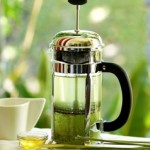Tea for You: Cold Brew Boosts the Brain

 When it’s hot out, a cup of iced tea is very refreshing, and the benefits far outweigh so many other drinks on the market. The theaflavins in both green and black teas help improve blood flow, keeping your skin fresh and your brain young. Because tea is so beneficial, I’ve developed many recipes with it for my cookbook, FoodTrients: Age Defying Recipes for a Sustainable Life.
When it’s hot out, a cup of iced tea is very refreshing, and the benefits far outweigh so many other drinks on the market. The theaflavins in both green and black teas help improve blood flow, keeping your skin fresh and your brain young. Because tea is so beneficial, I’ve developed many recipes with it for my cookbook, FoodTrients: Age Defying Recipes for a Sustainable Life.
One of my simplest tea recipes is Pomegranate Iced Tea. I simply blend pomegranate juice with brewed black tea that has been chilled. Catechins found in black tea inhibit the growth of cancer cells, stimulate metabolism, act as an anti-inflammatory, and can help lower cholesterol. The flavor combination of this drink is as lovely as the color. The antioxidant power of the pomegranates works with the catechins in black tea to make this an anti-aging super drink.
What about caffeine? The caffeine in tea has been found to reduce the risk of developing Parkinson’s disease and Type 2 diabetes. Caffeine stimulates the central nervous system and cardiac muscle and aids digestion by increasing gastric secretions. Still, some people prefer decaffeinated tea. The decaffeination process leaves the pholyphenols and catechins intact, so feel free to use decaffeinated tea in any of my recipes.
Theaflavins that occur naturally in green tea are good for our cognitive power because they increase blood flow to the brain, improving memory and helping us to focus. In Asian countries, people not only drink tea every day, they also cook with it. I have recipes for “eating” green tea, too. My Green Tea Noodles with Edamame (see recipe in the Recipe section) is delicious and refreshing when eaten cold on a hot day. I cook the soba noodles in green tea instead of water. You can apply this trick with rice as well, but the tea is less bitter when it’s cooked for a shorter period of time. Even ramen noodles can be cooked in green tea to give them a nutritional boost.
My Chia Seed Treat dessert, which is featured in my cookbook, is a very Asian concoction, but I find that Americans enjoy it quite a bit. It has many textures, flavors, and colors. I start by laying chilled coconut-moringa gelatin cubes laid in the bottom of a bowl. The morninga can actually be left out of this recipe if you have trouble finding it. Then I pour chilled green tea over the cubes. To sweeten things up, I drizzle brown-sugar syrup into the liquid. And for crunch (and their anti-inflammatory properties), I add some soaked chia seeds to the bowl. Then I top the whole dessert with crushed ice. It’s cold and refreshing and full of health benefits.
I also have a recipe for Honey-Lemongrass Tea (see recipe in the Recipe section) that is a favorite. This tea has a beautiful pale green color and a very light flavor. Technically, lemongrass isn’t a tea, but when it’s soaked in hot water it becomes an herbal tea, sometimes called a tisane. Like green and black tea and even honey, lemongrass has antibacterial and antioxidant properties. So this drink is pretty, very refreshing, and good for you.
I hope this inspires you to drink and eat more tea!